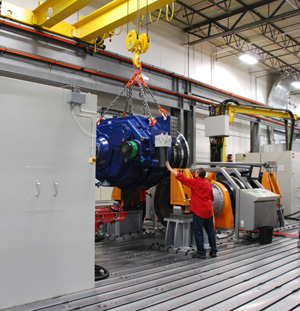Maximizing Turbine Performance: Full load gearbox testing
 The performance and reliability of a gearbox for a wind turbine is as important to the wind industry as the wind itself. In today’s service market, up-tower repairs are becoming more prevalent because they can provide a significant cost savings. More and more gearbox rebuild services can be performed up-tower, however, load testing isn’t available in this same manner. Customers are still required to take the time and money to remove the component from the turbine for repair.
The performance and reliability of a gearbox for a wind turbine is as important to the wind industry as the wind itself. In today’s service market, up-tower repairs are becoming more prevalent because they can provide a significant cost savings. More and more gearbox rebuild services can be performed up-tower, however, load testing isn’t available in this same manner. Customers are still required to take the time and money to remove the component from the turbine for repair.
Initial time and costs aside, down-tower repairs need full load testing as an assurance that the repairs performed not only meet the customer’s expectations, but also the specifications from the original equipment manufacturer. Not carrying out a full load test for a fraction of the overall down-tower expense could be a costly mistake in terms of future turbine performance and future return-on-investment (ROI).
A full load test to a repaired gearbox should ensure turbine owners and operators quality, reliability, and a guarantee that the repairs have met the same performance criteria as when the gearbox was originally installed. To this end, all original equipment gearboxes are tested before installation and, therefore, should come with validated testing certifications that can be used as a performance comparison to a repaired gearbox.
Failure to perform a full load test to a repaired gearbox means certain quality checks are missed on the work performed. There are five areas of importance when load testing a gearbox, which should be observed: temperature; vibrations; oil cleanliness; pressure; and noise/sound.
1. Temperature
When measuring temperature, there are three locations along the high-speed shaft (HSS) that are recorded. HSS Bearings are the source of many failures in a gearbox, so it’s extremely important that the maximum temperatures along the shaft and their Delta are properly measured. The oil temperature in the oil sump should also be measured to check the performance of the cooling system. Assessing the temperatures and their Deltas helps to find potential failure points, allowing a manufacturer to make improvements or share suggestions for upgrades if the parts are sourced from an outside supplier.
2. Vibration testing
When testing for vibrations, there is a five-point test that’s performed. These areas include: the high-speed shaft axial and radial directions; intermediate shaft axial and radial directions; and the low-speed gears of the planetary section. By monitoring the frequency of every tooth on the HS shaft, IM shaft, and planetary gear, it’s possible to measure if vibrations are either exceeding or are outside of the limits at a given frequency. This, in turn, allows for the identification of a gear or tooth that has a potential issue and is the source of the vibration.
3. Oil cleanliness & pressure
During a full load test, the oil pressure is constantly monitored to gauge the performance of the pump and filtration system. Upon completion of this test, the oil is drained and filtered to check for fine metal particles from the break-in and initial use of the gearbox with new or reworked parts.
4. Noise/sound testing
Using a bi-directional phase-matched microphone, the gearbox is sound tested in three areas, including on the left side, the right side, and at the top of the gearbox. The microphone is slowly moved over the areas in a large and tight “S” pattern. When performing this test, one is looking for the comparison of sound frequencies to the sensitivity of the human ear. It’s important to avoid and not have excessive sounds at certain frequencies for ideal performance.
Full load test station
After completion of the full load test a bore scope inspection is performed. The purpose is to look for patterns of wear on the gear teeth. When reassembling a gearbox, the teeth on the gears are dye-coated so, upon completion of the testing, the repair facility can observe the contact pattern of the mating gear teeth. If during the vibration test an issue is found, the gear alignment can then be checked and possible causes detected. If for whatever reason, the cause for the vibration cannot be detected from the bore scope inspection, then disassembly of the gearbox might be necessary. After disassembly to determine the root cause of an issue, the gearbox will go through yet another cycling on the full load test station.
Using a full load test station for gearbox repair often acts as a continuous improvement tool for the rebuilder. Not all third-party gearbox repair facilities have access to this testing station, however, and they might need to outsource load testing. This allows them to monitor and evaluate their work performance, while ensuring any repairs were successful.
Gearbox testing is a significant service to a turbine owner as it potentially lowers operating costs, ideally providing for fewer future onsite or up-tower repairs, or even down-tower repairs. Every failure, whether under warranty or out of warranty, causes lost revenue to the wind farm, ultimately resulting in higher total operating costs to the manufacturer and operator.
When sourcing to have a gearbox repaired down-tower, it’s worth taking the time to ask if a full load test will be performed. Some repair facilities only perform a spin test. A full load test simulates what the wind turbine experiences at higher wind speeds and loads. The differences between a spin test and a full load test may be more than just the financial expense—it could be the difference between increased failures and lost revenues, versus achieving the maximum production from a turbine during the warranty and beyond.
Justin Hynes is the product manager for ZF Services, LLC.
ZF Services, LLC
www.zf.com/us
Author: Justin Hynes
Volume: September/October 2013










.jpg?r=3127)
